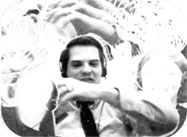Dedication
Introduction
Dan Ariely
Walter Bender
Steve Benton
Bruce Blumberg
V. Michael Bove, Jr.
Cynthia Breazeal
Ike Chuang
Chris Csikszentmihályi
Glorianna Davenport
Judith Donath
Neil Gershenfeld
Hiroshi Ishii
Joe Jacobson
Andy Lippman
Tod Machover
John Maeda
Scott Manalis
Marvin Minsky
William J. Mitchell
Seymour Papert
Joe Paradiso
Sandy Pentland
Rosalind Picard
Mitchel Resnick
Deb Roy
Chris Schmandt
Ted Selker
Barry Vercoe
V. Michael Bove, Jr.
My passion is working in an environment in which learning happens constantly—where students and faculty members learn things from one another, exchanging information with our sponsors and the world at large. And we do so in an environment devoid of seemingly arbitrary limitations....
It's time we took seriously the topic of time travel. Not in the quantum-mechanics sense, but in the sense of better supporting communication, expression, learning, and collaboration among people who are separated temporally, and in the sense of removing the sharp divide between "live" and "recorded" (which right now all too often involve different devices, applications, interfaces, and even etiquettes). Ultimately people should be able to transition seamlessly—and probably in many cases invisibly—between asynchronous and synchronous communication.
This isn't just a clever user-interface hack; rather, properly solving the problems involves learning what the users are trying to accomplish. The idea ties in strongly with my interest in communication systems that gain an understanding of what it is that they're communicating, and then use that understanding to create richer connections among the people at the ends of the system. What makes this a Media-Lab-style project is that the goal is not to make better voice mail or chat rooms or collaborative-work software, but to extend the freedom from time constraints into all aspects of life, and in particular to physical spaces.

In order to do that, we have to aggregate many sources and types of input, a requirement well-served by my group's (and others') work in unorthodox, highly-scalable, distributed intelligence approaches to the computational needs of smart communication systems (e.g. Eye Society and Paintable Computing). It's likely to be a few more years and another generation or two of students before we have anything like a proper theory of how to domesticate these things, but we must get there.
We've also just begun exploring a corollary to the time travel idea, that of situated memory. What if, as an exercise, we were to tie memory inseparably to a space rather than to devices in it? Could a room itself be the means by which I collaborate with someone who works different hours? Could a lecture hall somehow forever resonate with all the lectures, and the intra-audience discussions, that have taken place in it? How does a location disclose its history to me? What happens to privacy concerns when information can only be consumed in the place in which it was gathered?
First computer: one I built in high school (1976); it had a CCD camera, video digitizer, and a great flight simulator.